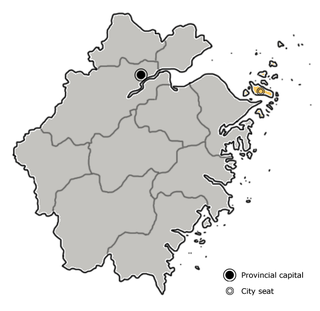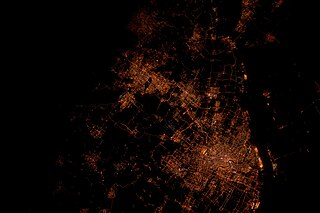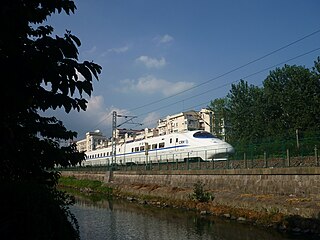Related Research Articles

Zhejiang is an eastern, coastal province of the People's Republic of China. Its capital and largest city is Hangzhou. Zhejiang is bordered by Jiangsu and Shanghai to the north, Anhui to the northwest, Jiangxi to the west and Fujian to the south. To the east is the East China Sea, beyond which lies the Ryukyu Islands. The population of Zhejiang stands at 57 million, the 10th highest among China. Other notable cities include Ningbo and Wenzhou. It has been called 'the backbone of China' due to being a major driving force in the Chinese economy and being the birthplace of several notable persons, including the Chinese Nationalist leader Chiang Kai-shek and entrepreneur Jack Ma. Zhejiang consists of 90 counties.

Ningbo, formerly romanized as Ningpo, is a major sub-provincial city in northeast Zhejiang province, People's Republic of China. It comprises 6 urban districts, 2 satellite county-level cities, and 2 rural counties including several islands in Hangzhou Bay and the East China Sea. Ningbo is the northern economic center of the Yangtze Delta megalopolis, and is also the core city and center of the Ningbo Metropolitan Area. To the north, Hangzhou Bay separates Ningbo from Shanghai; to the east lies Zhoushan in the East China Sea; on the west and south, Ningbo borders Shaoxing and Taizhou respectively. As of the 2020 Chinese National Census, the entire administrated area of Ningbo City had a population of 9.4 million (9,404,283).

Shaoxing is a prefecture-level city on the southern shore of Hangzhou Bay in eastern Zhejiang province, China. It was formerly known as Kuaiji and Shanyin and abbreviated in Chinese as 越 (Yuè) from the area's former inhabitants. Located on the south bank of the Qiantang River estuary, it borders Ningbo to the east, Taizhou to the southeast, Jinhua to the southwest, and Hangzhou to the west. As of 2010, its population was 4,912,339 inhabitants. Among which, 1,914,683 lived in the built-up metropolitan area of Hangzhou-Shaoxing, with a total of 8,156,154 inhabitants.

Zhoushanlisten (help·info), formerly romanized as Chusan, is an urbanized archipelago with the administrative status of a prefecture-level city in the eastern Chinese province of Zhejiang. It consists of an archipelago of islands at the southern mouth of Hangzhou Bay, off Ningbo. The prefecture's city proper is Dinghai on Zhoushan Island, now administered as the prefecture's Dinghai District. During the 2010 census, Zhoushan Prefecture's population was 1,121,261, out of whom 842,989 lived in the urban districts of Dinghai and Putuo.

The Yangtze Delta or Yangtze River Delta is a triangle-shaped megalopolis generally comprising the Wu Chinese-speaking areas of Shanghai, southern Jiangsu province and northern Zhejiang province. The area lies in the heart of the Jiangnan region, where the Yangtze River drains into the East China Sea. Having fertile soil, the Yangtze Delta abundantly produces grain, cotton, hemp and tea. In 2018, the Yangtze Delta had a GDP of approximately US$2.2 trillion, about the same size as Italy.

Taizhou, alternately known as Taichow, is a city located at the middle of the East China Sea coast of Zhejiang province. It is located 300 km (190 mi) south of Shanghai and 230 km (140 mi) southeast of Hangzhou, the provincial capital. It is bordered by Ningbo to the north, Wenzhou to the south, and Shaoxing, Jinhua, and Lishui to west. In addition to the municipality itself, the prefecture-level city of Taizhou includes 3 districts, 3 county-level cities, and 3 counties. At the 2010 census, its population was 5,968,838 inhabitants whom 3,269,304 lived in the built-up area made of 3 urban Districts and Wenling City now being largely conurbated.

Hangzhou Bay, or the Bay of Hangzhou, is a funnel-shaped inlet of the East China Sea, bordered by the province of Zhejiang and the municipality of Shanghai, which lies north of the Bay. The Bay extends from the East China Sea to its head at the city of Hangzhou, from which its name is derived.
The Port of Ningbo-Zhoushan is a port that is the busiest in the world in terms of cargo tonnage. It handled 888.96 million tons of cargo in 2015. The port is located in Ningbo and Zhoushan, on the coast of the East China Sea, in Zhejiang province on the southeast end of Hangzhou Bay, across which it faces the municipality of Shanghai.

Jintang Island (金塘岛) is an island in the Zhoushan prefecture-level city in China's eastern Zhejiang province. It has a population of about 41700.

Wenling is a coastal county-level city in the municipal region of Taizhou, in southeastern Zhejiang province, China. It borders Luqiao and Huangyan to the north, Yuhuan to the south, Yueqing to the west, looks out to the East China Sea to the east. Wenling locates on 28°22'N, 121°21'E, approximately 300 km (190 mi) south of Shanghai.

Sanmen County is a coastal county under the jurisdiction of Taizhou city/municipality in the east of Zhejiang Province, People's Republic of China. The county's total area is 1,072 km2 (414 sq mi), and has a population of about 400,000 people. The county's postal code is 317100. The county government is located at 59 Renmin Road, in the town of Haiyou.
Taihu Wu (吳語太湖片) or Northern Wu (北部吳語) is a Wu Chinese language spoken over much of southern part of Jiangsu province, including Suzhou, Wuxi, Changzhou, the southern part of Nantong, Jingjiang and Danyang; the municipality of Shanghai; and the northern part of Zhejiang province, including Hangzhou, Shaoxing, Ningbo, Huzhou, and Jiaxing. A notable exception is the dialect of the town of Jinxiang, which is a linguistic exclave of Taihu Wu in Zhenan Min-speaking Cangnan county of Wenzhou prefecture in Zhejiang province. Used in regions around Taihu Lake and Hangzhou Bay, this group makes up the largest population among all Wu speakers. Taihu Wu dialects such as Shanghainese, Shaoxing and Ningbo are mutually intelligible even for L2 Taihu speakers.

Shaoxing North railway station is a railway station on the Hangzhou–Ningbo high-speed railway located in Yuecheng District, Shaoxing, Zhejiang, China. In the future, the station will be served by Line 1 of the Shaoxing Metro.

The Ningbo−Zhoushan Expressway, commonly referred to as the Yongzhou Expressway is an expressway in Zhejiang, China which links Ningbo to Zhoushan. In the National Trunk Highway System (NTHS) in China, the number of this highway is G9211.

The Ningbo–Taizhou–Wenzhou railway is a dual-track, electrified, high-speed rail line in Zhejiang Province. The line, also known as the Yongtaiwen railway, is named after the three primary cities along route: Ningbo, whose abbreviated Chinese name is Yong, Taizhou and Wenzhou. The line has a total length of 282.4 kilometres and forms part of China's Southeast Coast high-speed rail corridor. Construction began in October 2005, and the line opened to commercial service on September 28, 2009. Trains running on the line reach top speeds of 250 kilometres per hour, and the shortest trip between Ningbo and Wenzhou takes 1 hour 12 minutes.

The Xiaoshan–Ningbo railway or Xiaoyong railway, is a double-track railroad in eastern China between Hangzhou and Ningbo in Zhejiang Province. Its name in Chinese, the Xiaoyong Line, is named after the railway's two terminal stations, Xiaoshan, a suburban district of Hangzhou on the southern bank of Qiantang River, and Ningbo, whose Chinese character abbreviation is yong. The line is 147.3 km (92 mi) long and was originally built in three parts in 1912, 1914 and 1936; rebuilt in 1959, then electrified in 2009. Cities along route include Xiaoshan District of Hangzhou, Shaoxing, Shangyu, Yuyao and Ningbo, all in Zhejiang Province. The Hangzhou–Ningbo high-speed railway runs parallel to the line. The section between Ningbo and Zhuangqiao railway station is proposed to be quadruple-tracked.

The Shenyang–Haikou Expressway, commonly referred to as the Shenhai Expressway is an expressway in China that connects the cities of Shenyang, Liaoning, and Haikou, Hainan. When fully complete, it will be 3,710 km (2,310 mi) in length. One of its oldest portions is the Shenyang–Dalian Expressway, or Shenda Expressway is a 400 km (250 mi) expressway that connects Shenyang and Dalian, the two largest cities of China's Liaoning province.
Dongguan railway station may refer to: